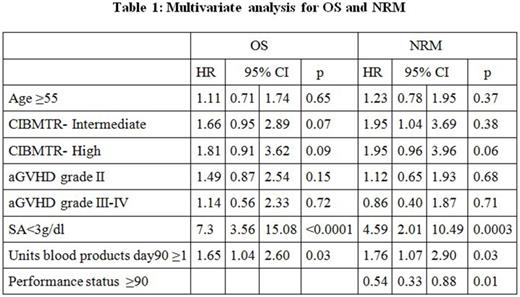Abstract
Introduction
Pretransplant patient and donor characteristics can predict outcomes after allogeneic hematopoietic cell transplantation (HCT), but the utility of post-transplant characteristics to predict outcomes after HCT remains unknown. Our group previously noted that hypoalbuminemia (<3.0 g/dl) at day +90 predicts for worse overall survival (OS) and non-relapse mortality (NRM) after allogeneic (allo) HCT in myeloid malignancies. In this study we evaluated several variables at day+90 for predictors of OS and NRM in patients (pts) who underwent allo-HCT for lymphoid malignancies.
Methods
We identified pts with lymphoid malignancies who underwent allo-HCT at Moffitt Cancer Center from 2/1/2005 to 3/22/2013. Patient, donor and transplant characteristics from before and day+90 after HCT were retrospectively reviewed. OS was calculated by Kaplan-Meier estimates. NRM was determined by competing risk analysis. Multivariable models were developed for both endpoints. Patient's age, Center for International Blood and Marrow Transplantation Research (CIBMTR) risk category and acute graft versus host disease (aGVHD) grade were forced into the multivariate model along with significant covariates.
Results
271 pts met the inclusion criteria (65% male, 35% female) with median age of 50 years. HCT indications were chronic lymphocytic leukemia (14%), Hodgkin's lymphoma (7%), non-Hodgkin's lymphoma (44%) and acute lymphoblastic leukemia (35%). CIBMTR disease risk categories were low (30%), intermediate (55%), or high (15%). Stem cell source was mainly peripheral blood (92%). Most common conditioning regimens were fludarabine + busulfan (69%) and pentostatin + busulfan (12%).
25 pts (9.2%) died prior to day+ 90 and were excluded from outcomes analyses. For the 249 evaluable pts, median OS was 78.4 months (95% CI: 32.1, NR). The 2-year and 5-year OS were 59% and 54% respectively. The 2-year and 5-year cumulative incidence of NRM were 19% and 21% respectively. On univariate analysis, transfusion of any blood product prior to day +90 (HR 1.82, CI 1.23-2.70, p=0.0028), prednisone dose of ≥20mg/day at day +90 (HR 2.18, CI 1.43-3.33, p=0.0003), and serum albumin(SA) of <3g/dl at day+90 (HR 7.06, CI 3.95-12.62, p<0.0001) correlated with worse OS while Karnofsky performance status of ≥90 at day+90 (HR 0.51, CI 0.32-0.80, p=0.0033) predicted for better OS. On multivariate analysis, SA <3g/dl (HR 7.3, CI 3.56-15.08, p<0.0001) and transfusion of any blood product prior to day+90 (HR1.65, CI 1.04-2.60, p=0.03) retained prognostic value for OS.
Similarly, univariate analysis showed that transfusion of any blood product prior to day+90 (HR 1.82, CI 1.04-3.18, p=0.03), SA of 3-3.5g/dl (HR 2.04, CI 1.14-3.65, p= 0.02) and prednisone dose of ≥20mg/day (HR 3.07, CI 1.76-5.37, p<0.0001) correlated with worse NRM while performance status ≥90 (HR 0.41, CI 0.22-0.78, p=0.0066) was predictive of better NRM. NRM was found by multivariate analysis to be worse for SA <3g/dl (HR 4.59, CI 2.01-10.49, p=0.0003) and transfusion of blood product prior to day+90 (HR1.76, CI 1.07-2.90, p=0.03) but better for performance status ≥90 (HR 0.54, 0.33-0.88, p=0.01).
A prior or current diagnosis of aGVHD did not predict for NRM or OS in the multivariable models consistent with results on the myeloid malignancy study. Patient age, disease risk, comorbidity index, CD34 cell dose and GVHD prophylaxis type did not significantly predict for OS or NRM (Table 1).
Conclusion
Our study supports the adverse prognostic value of day +90 hypoalbuminemia (< 3g/dl) in regards to NRM and OS in pts who undergo allo-HCT for lymphoid malignancies. We propose inclusion of serum albumin at day +90 in algorithms to predict HCT outcomes.
No relevant conflicts of interest to declare.
Author notes
Asterisk with author names denotes non-ASH members.


